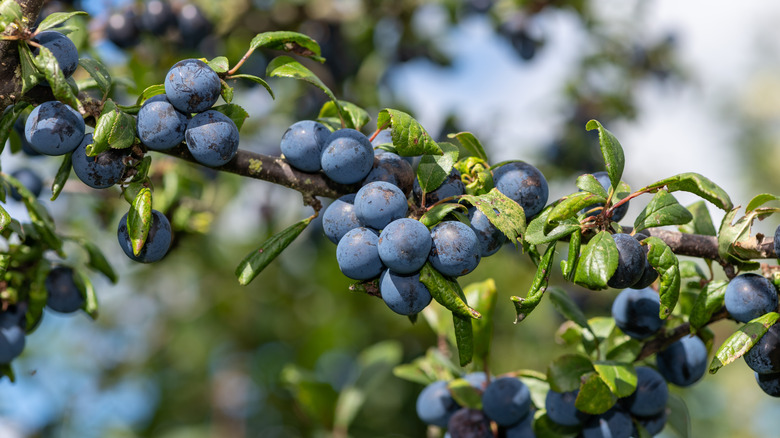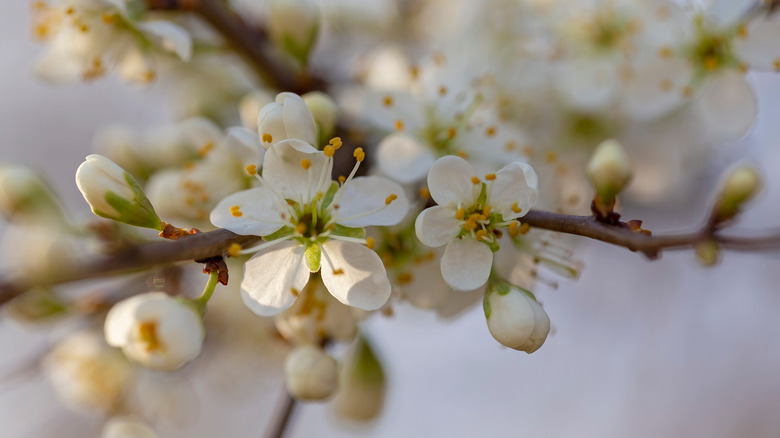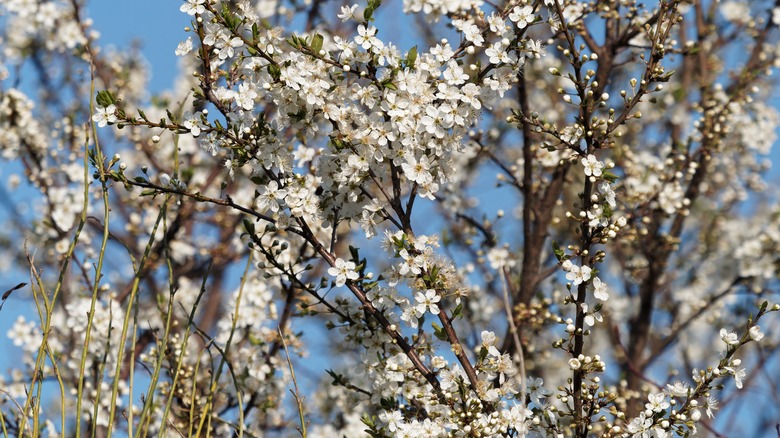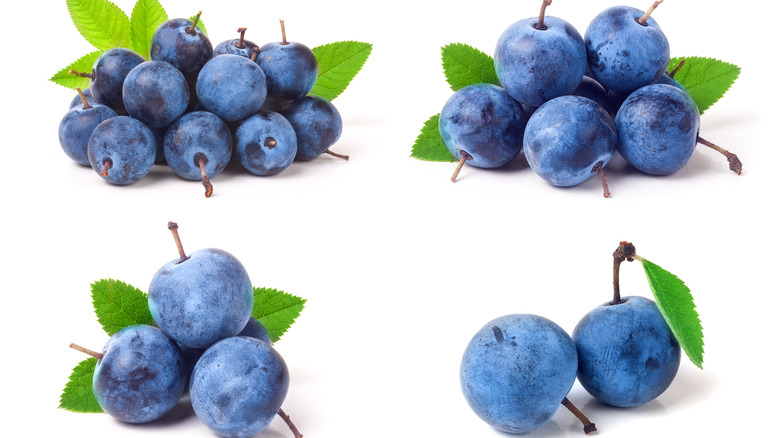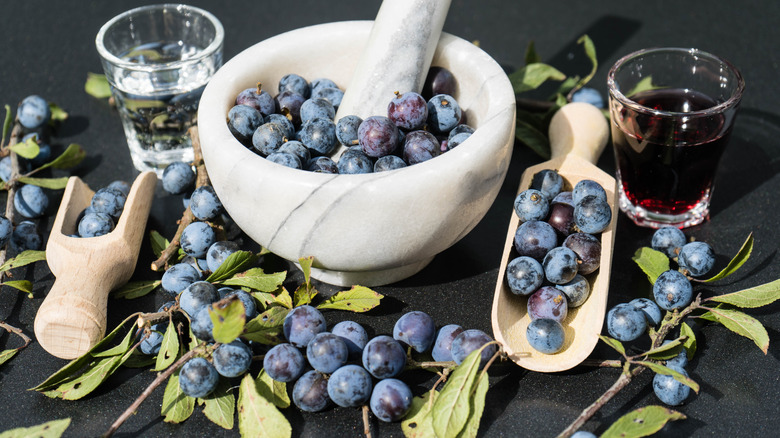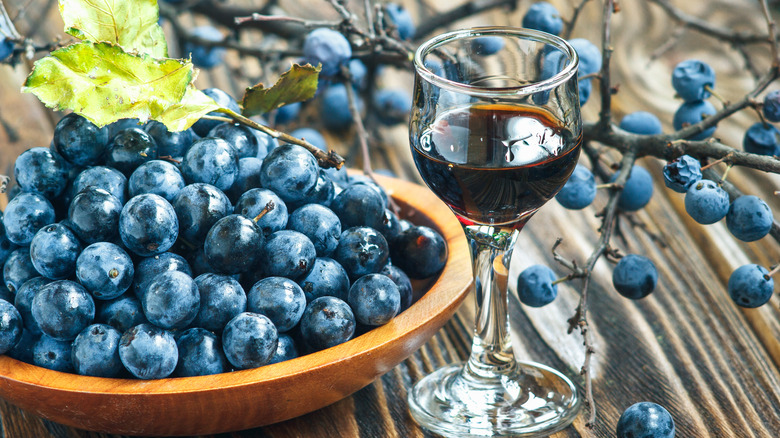How To Grow And Care For A Sloe Berry Plant
Sloe berry plants (Prunus spinosa), also known as blackthorn, are thorny, flowering plants in the Rose family. They usually grow as a bush but can take the form of small trees under the right conditions. The flowers are a creamy white, and the branches are dark and stiff. Often confused with the cherry plum tree, they bloom in early spring. The fruit is called sloe, a dark fruit resembling cherries or grapes, and is used for jams as well as other beverages.
The sloe fruit is used in the United Kingdom for gin, and the plant's branches are sometimes used to make walking sticks. According to Nature & Garden, it's also a popular spot for birds to build their nests, as the sharp thorns help protect the eggs from harmful predators. It's a very interesting and multi-use plant that has a long life if cared for properly. So how do you grow and care for a sloe berry plant?
How to use sloe berry plant in the garden
Blackthorn might be hard to find as it's native to Europe and Western Asia, but a good nursery or online retailer will have it available. Once you find it, planting and caring for it is relatively easy. The first thing you need to do after getting it is decide how you want to use it. Is it purely for decoration with the pretty white flowers, or would you like to use it for the berry sloes for jams or gin? Deciding that first will help in making a plan for the best care needed.
If used purely for decoration, the white flowers are not only beautiful but are a great source of pollen and nectar for insects. Resembling the beautiful cherry blossoms, this shrub really makes a garden stand out. The plant also makes an excellent security hedge, according to Hedges Direct, because of its dense and thorny branches, which is why a lot of small animals make a home there to protect their eggs and offspring.
How to grow a sloe berry plant
The sloe berry plant needs full sun, so be sure to plant it in an area outside that will be exposed to sunlight all day. The plant is also not picky with soil, as long as it's not standing water. Ginblogger doesn't recommend growing blackthorn in a pot because of how fast it grows. Instead, plant it in the ground and water it regularly, at least for the first year.
Once you've got a blooming blackthorn plant, wait until about late autumn before picking the berries. They will look like small, round plums. If you are looking to use the berries in the kitchen, timing is everything. However, when collecting at the right time, you can make them into delicious jams and treats, as well as the popular sloe gin (via Sipsmith).
There are several ways to propagate or grow a sloe berry plant to either expand your garden or make a new home for one. According to Plantura, you need to collect the seeds and store them in the refrigerator over winter. Once spring hits, plant them on the ground and watch them grow. To propagate from cuttings, cut about 7 inches from the plant, removing the thorns and leaves and putting them in potting soil. Wear puncture-proof gloves as those thorns can be dangerous.
Sloe berry plant varieties
Because their fruits look like blueberries or small plums and don't grow in the United States as easily, it can be a bit tough to get a true blackthorn tree. However, once you buy it (or find the seeds to grow), you'll be able to reap the benefits for years to come. There are a few types of sloe berry plants to take note of. Experts at Plantura list several varieties, including:
- Godenhaus — This plant is strong and provides a high yield.
- Merzig — This variety is best for liqueur and gin.
- Nittel — This type is the easiest to care for.
- Purpurea — Boasting purple and red foliage, this plant has pink blooms.
- Reto — This variety is fairly new, with the fruit being a bit bigger than the regular blackthorn.
- Rosea — With beautiful pink flowers instead of white, this kind blooms in late March and April.
- Trier — This variety is the most similar to wild blackthorn.
While you may have your eyes set on a particular variety, if you can get your hands on blackthorn seeds or cuttings, start with what you can find and then look for types that have the qualities you want in a sloe berry plant.
Is the sloe berry plant toxic?
One of the most popular questions people ask about a berry plant is if the fruit is edible to humans. Yes, it is. The sloe berry plant is used for gin and other liqueurs, as well as jams, syrups, and treats. Birds and other animals munch on the fruit with no harm to them. However, according to Gardening Know How, the sloe berry seeds, leaves, and bark do contain a small amount of hydrogen cyanide, which in large doses can have a significant poisoning effect.
That being said, the fruit it's been used for a variety of consumables. For instance, the sloe gin is a very popular drink served in the United Kingdom to symbolize the start of winter. However, when using the fruit for consumption, it's best to be careful in selecting what parts to eat. The seeds are poisonous and should be removed before cooking or boiling the fruit. The leaves should also be removed if attached.
How to harvest a sloe berry plant
Harvesting the berries to make jams, jellies, and gin is an easy process, but the trick is making sure to pick them up at the right time. Pick them too early, and the taste is awful, pick them too late, and you'll get slim pickings as the birds might've gotten to them first. According to The Guardian, if harvested before late autumn or before the first frost, the berries will be super bitter and not very useable. However, if you happen to pick them up early, try putting them in the freezer overnight, as it can sometimes help the ripening process. A good way to test if the sloe berries are good to go is if they feel mushy and look overripe. Then you are good to go!
Since blackthorn is an easy plant to care for and is fairly low maintenance, this shrub is definitely an interesting addition to have in your garden. From beautiful flowers to ripe berries for that gin and tonic, the tree keeps on giving.
